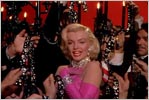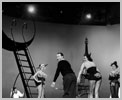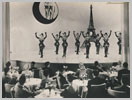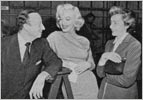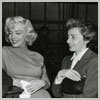
My journey ends here...
Gentlemen Prefer Blondes
(1953)
Posters
For her 26th birthday (1952), while she was celebrating it at the Bel Air Hotel,
where she lived at that time, Marilyn learned that she had get the such desired part of Lorelei Lee.
Darryl Zanuck,
head of the studio, had prefered her to Betty Grable, after having
heard a non commercialized extract of her voluptuous voice singing "Do
It Again" for the Marines at Camp Pendleton, during the same year.
The other reason -
and not the least - why Marilyn supplanted Betty Grable, though more
experienced than her, was that Marilyn's contract was written in such a
way that she cost 10 times less than Betty Grable, and even her partner
in the movie,
Anita Loos wrote 3 screenplays of Jean
Harlow's movies.
The book inspired a movie in 1928 with Ruth Taylor and Alice White, then in 1950, a successful musical in Broadway, with Carol Channing, who was for a moment competing for the movie version.
It was Marilyn's first part in a musical. She sang as a duo with Jane Russell
In one of the acts, cut during the film editing, and known as the "Four French Dances", Marilyn and Jane Russell appeared with hats in shape of Eiffel Tower; they can briefly been seen with such costumes, at the beginning of the movie, when Gus met the young ladies for the first time.
As ususal, the shooting was difficult.
Jane Russell told how Marilyn was terrified, but, instead their rivalry on the screen, the two actresses made friends on the set. The musical director Lionel Newman would later talk about Marilyn's perfectionism during the recording of the songs.
Director Howard Hawkes was less full of praise about her insistence to do the shootings again, even when he was himself totally pleased about her job.
For instance, he was totally satisfied of the first take of "Bye, Bye, Baby", but Marilyn asked to do it again 10 times.
(Awards).
"Diamonds Are a Girl's Best Friend"
 ,
, ,
, ,
, ,
, -
- ,
, ,
, ,
, ,
, -
- ,
, ,
, ,
, ,
, ,
, ,
, ,
, -
- ,
, ,
, ,
, ,
, ,
, ,
, ,
, ,
, ,
, ,
, -
- ;
; ;
; ,
,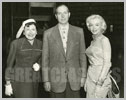 ;
;
Black and yellow leotard
"Four
French Dances" (scene finally cut)
Purple top
Green top
Bathrobe
Wedding gown
Grey dress
Gold lamé dress
Orange dress
Red spangled dress
"Two Little Girls From Little Rock"
 ;
; ,
, ,
, ,
, ,
, ,
,
Red and black dress
Blue suit
"When Love Goes Wrong"
Off set
 ;
; ,
, ;
;
Publicity pictures
Black leotard
Black and yellow leotard
Orange dress
Red spangled dress
Hairdressing tests
Wardrobe tests
Black and yellow leotard  ,
, ,
, ;
; ,
, ,
, ,
,
 ,
,
Costume designed but non used in the movie  ,
, -
- ,
, ;
;
CREDIT
Twentieth Century-Fox (Technicolor)
Runtime : 91 mn
Release date : July 15,
1953  .
.
Director : Howard Hawks
Producer : Sol C. Siegel
Screenplay : Charles Lederer, based on a musical by Joseph Fields and Anita Loos, and on a novel by Anita Loos published by episodes.
Director of photography
: Harry J. Wild
Music : Lionel Newman, Leo Robin, Jule Styne
Costumes : William Travilla
Film editing : Hugh S. Flower.
CAST
Jane Russell - Dorothy Shaw
Marilyn Monroe - Lorelei Lee
Charles Coburn - Sir Francis Beekman
Elliott Reid - Ernie Malone
Tommy Noonan - Gus Esmond
George Winslow - Henry Spofford III
Marcel Dalio - Magistrate
Taylor Holmes - Esmond Sr
Norma Varden - Lady Beekman
Howard Wendell - Watson
Steven Geray - Hotel Manager
Alex Frazer - Pritchard
Harry Carey Jr - Winslow
William Cabanne - Sims
George Chakiris - dancer
Jack Chete - Owner
John Close - Coach
George Davis - Taxi driver
TECHNICAL CREW
Claude E. Carpenter - set designer
Jack Cole - choregrapher
Eliot Daniel - vocal director
Leonard Doss - color consultant
Earle H. Hagen -
orchestrator
Paul Helmick - assistant director
Roger Heman - sound
Ray Kellogg - special effects
Charles LeMaire - wardrobe director
Bernard Mayers - orchestrator
Ben Nye - make-up
Herbert W. Spencer - orchestrator
E. Clayton Ward - son
Lyle R. Wheeler - art director
Joseph C. Wright - art director.
SCREENPLAY
Two bar girls,
Lorelei
Lee (Marilyn Monroe) and Dorothy Shaw (Jane Russell), take the boat to
Paris, where Lorelei is going to marry her rich fiancé, Gus
Esmond (Tommy Noonan).
Their doings on board are watched by a priovate detective, Malone (Elliott Reid), hired by Gus's father, who is convinced that Lorelei is interested in his son only for the money.
They succeed, after having given a sedative to Malone.
Lady Beekman (Norma Varden) declares the
theft of her tiara and Lorelei becomes the suspect number 1. Dorothy
helps her friend to muddle through by wearing a blonde wig to face the
judge instead of her. Meanwhile, Lorelei tries to convince Gus that she
truly loves him.
Malone finds out that Sir Beekman has get the tiara back and solves the problem by bringing it to the court. Dorothy, disguised in Lorelei, thanks Malone by showing him her affection. Lorelei regains Gus's love and his father approval. So, all's well that ends well : with a spectacular double wedding.
 BACK TO INDEX
NEXT FILE
BACK TO INDEX
NEXT FILE













